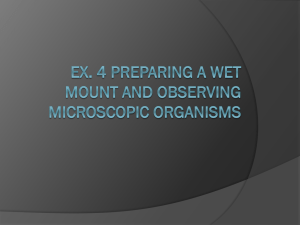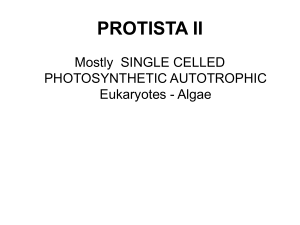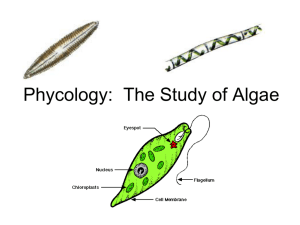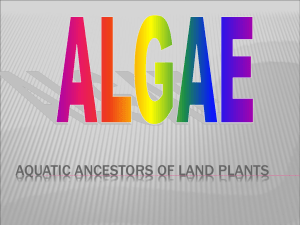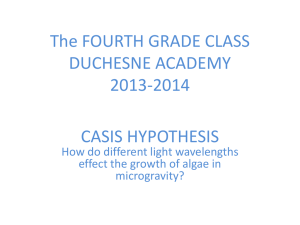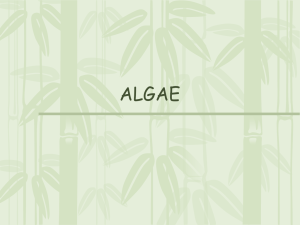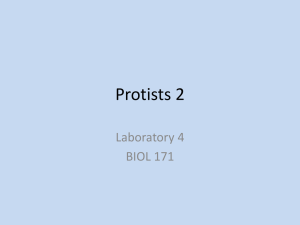Chapter 15 Part III - Division of Biology
advertisement
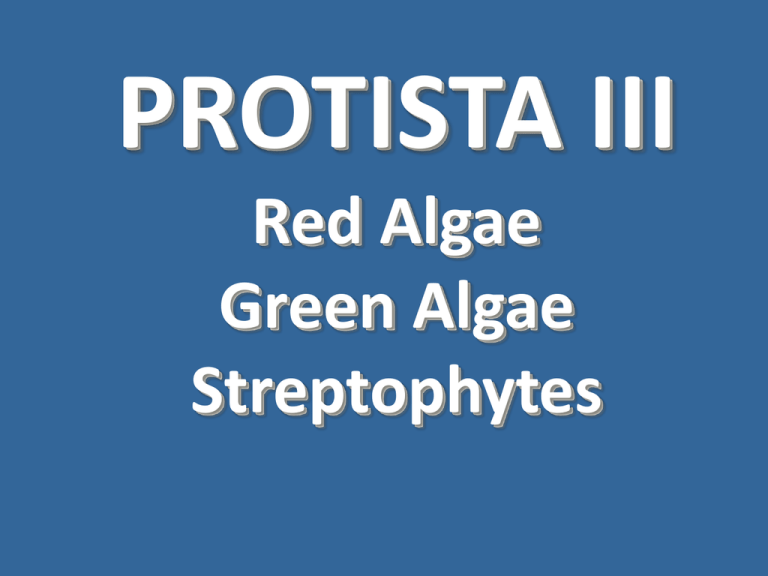
PROTISTA III Red Algae Green Algae Streptophytes Keeting et al. 2005 Trends in Ecology & Evolution Volume 20, Issue 12, Pages 670-676 THE EUKARYOTIC TREE OF LIFE Plantae Chlorophyll a Chlorophyta Rhodophyta PLANTAE ORIGIN Primitive archea-like cell with or without nuclear membrane Prochloron-like prokaryote Chlorophyll a Prokaryote with respiration (can make ATP from oxidation of organic substrates) PHYLUM RHODOPHYTA red algae Coralline Red Alga Keeting et al. 2005 Trends in Ecology & Evolution Volume 20, Issue 12, Pages 670-676 THE EUKARYOTIC TREE OF LIFE Rhodophyta • Pigments: • chlorophyll a • carotenoids and phycobilins • Photosynthetic reserve: Floridean starch (a highly branched starch) • Cell Wall composition: cellulose, calcium, pectin • Reproductive Mobility: None • Habitat: mostly marine and rare fresh water species Phycoerythin reflects red light and absorbs blue light. Because blue light penetrates water to a greater depth than light of longer wavelengths, these pigments allow red algae to photosynthesize and live at somewhat greater depths than most other algae. Some rhodophytes have very little phycoerythrin, and may appear green or bluish from the chlorophyll and other pigments present in them. Boldia-local freshwater species Red algae actually has 3 “generations” 2=n 3=2n 1=2n Most red algae have a complex life history with three phases: tetrasporophyte, gametophyte, and carposporophyte. Economic importance Agar: a polysaccharide from the red algae Gelidium gracilaria found in the far east and Mediterranean. Primary medical use is for growth of bacteria. Food: In Asia, rhodophytes are important sources of food, such as nori. The high vitamin and protein content of this food makes it attractive, as does the relative simplicity of cultivation, which began in Japan more than 300 years ago. Reefs: Some rhodophytes are also important in the formation of tropical reefs, an activity with which they have been involved for millions of years; in some Pacific atols, red algae have contributed far more to reef structure than other organisms, even more than corals. These reef-building rhodophytes are called coralline algae, because they secrete a hard shell of carbonate around themselves, in much the same way that corals do. The red alga genus Hypnea is a source of carageenan, a common food additive Irish moss (Chondrus crispus) from Nova Scotia – The most common red alga and a source of carageenans Tie for 1st place in Science photography contest Prior to WW2, the Japanese produced all of our agar for medical use. With the start of WW2, a search began for American based seaweed and the carageenan industry was born FOOD APPLICATIONS: Beer/Wine/ Vinegar -accelerates and improves clarity. Chocolate Milk Drink -stabilizes and improves viscosity. Ice cream -prevents ice crystals formation. -enhances excellent mouthfeel. Flans/Dessert Gel-enhances flavor release and excellent mouthfeel Sauces and Dressings -thickens and improves viscosity. Even the pimento in your martini olives is from a pimento-algae sludge PROCESSED MEAT Beef Patty -substitutes fat, retains moisture and increase yield. Luncheon Meat -prevents fat separation serves as a meat extender. Poultry and Ham -controls dehydration of frozen poultry, enhances juiciness and increase yield. NON-FOOD APPLICATIONS Petfood Canned meat and fish -gelling and stabilizing agent. Moist, solid petfood -binder. Toothpaste-stabilizer. Air freshener-gelling agent. Carageenan has anti-viral properties against human HPV and cold virus PHYLUM CHLOROPHYTA (green algae) Keeting et al. 2005 Trends in Ecology & Evolution Volume 20, Issue 12, Pages 670-676 THE EUKARYOTIC TREE OF LIFE Green Algae Pigments: chlorophyll a and b, occasionally c carotenoids and phycobilins Photosynthetic reserve: starch Cell Wall composition: polysaccharides Reproductive Mobility: Varied numbers of flagella Habitat: Marine and rare fresh water species Class Ulvophyceae Ulva Ulva life cycle is sporic meiosis (aka alternation of generations) The complete life cycle pattern has three kinds of organisms (1) Sporophyte (2) Female gametophytes (3) Male gametophytes also see lab book Generalized Life Cycles The life cycle alternates between haploid and diploid phases (alternation of generations) The haploid phase begins after cells undergo the cellular process of meiosis The diploid phase begins after haploid cells fuse Unlike higher plants, the haploid and diploid stages are usually free living REQUIRED LIFE CYCLE Gametophyte n Gametophyte n meiosis mating Sporophyte 2n Zygote 2n Ulvophyceae Class Chlorophyceae Volvox Chlorophyta - Volvox A colonial green alga - Volvox Individual cells are connected by cytoplasmic threads Asexual reproduction forms by invaginating and forming daughter colonies Motile colonies due to the presence of flagella Sexual reproduction: Volvox Some of the enlarged cells that grow into daughter colonies become eggs instead packets of sperm are produced elsewhere in the colony and swim to the egg fertilization produces a zygote. zygotes go through a dormancy period then undergo meiosis and release haploid zoospores Asexual Sexual Hydrodictyon Colonial Non-motile organism: the water net Hydrodictyon is coenocytic STREPTOPHYTA A clade consisting of the land plants plus their closest relatives, the charophytes. Keeting et al. 2005 Trends in Ecology & Evolution Volume 20, Issue 12, Pages 670-676 THE EUKARYOTIC TREE OF LIFE Chlorophyta Land plants (embryophytes) evolved from streptophyte green algae, a small group of freshwater algae ranging from scaly, unicellular flagellates (Mesostigma) to complex, filamentous thalli with branching, cell differentiation and apical growth (Charales). Streptophyte algae and embryophytes form the division Streptophyta, whereas the remaining green algae are classified as Chlorophyta Class Charophyta Spirogyra Zygnema Coleochaete Chara The early freshwater adaptation of streptophyte algae was a major advantage for the earliest land plants, even before the origin of the embryo and the sporophyte generation. Spirogyra sp filamentous ornate chloroplasts large nuclei reproduction by conjugation-”scaleriform” Spyrogyra sp. Life cycle of spirogyra Conjugation bridge Meiosis, only one of the cells germinates Zygnema sp. Distinguishing factor is the presence of stellate chloroplasts rather than ribbonlike chloroplasts Coleochaete (fresh water) Coleochaete and Chara are most like higher plants zygotes remain attached to the parental thallus Node and internode Chara Antheridia and oogonia Freshwater algae Chara oogonium (left) and antheridium (right). Chara is characterized by whorls of branches along the main axis, grey-green color and a garlic or skunk-like odor. Sperm cells resemble those of mosses. Image is from Carolina Biologicals “Unseen world” screensavers END


